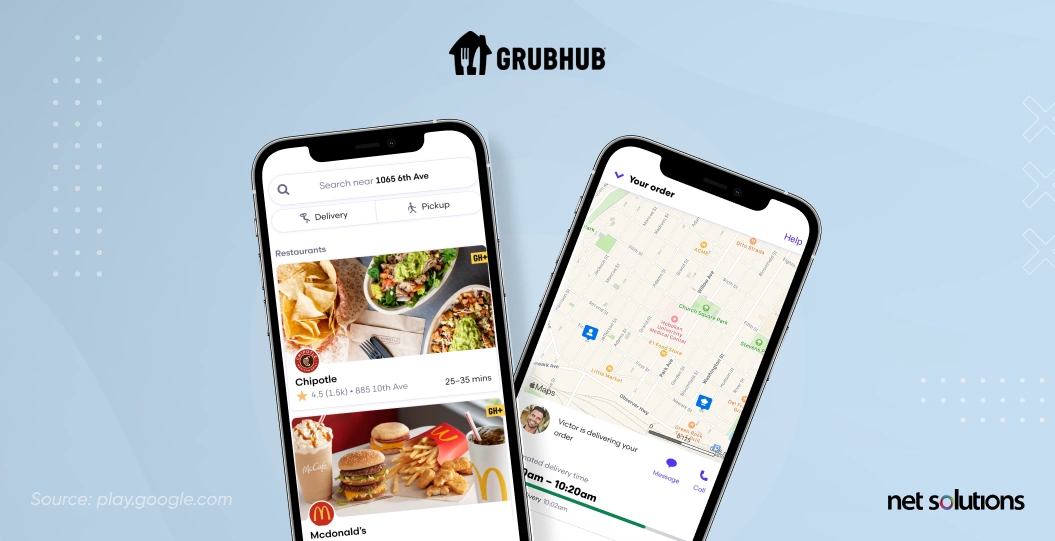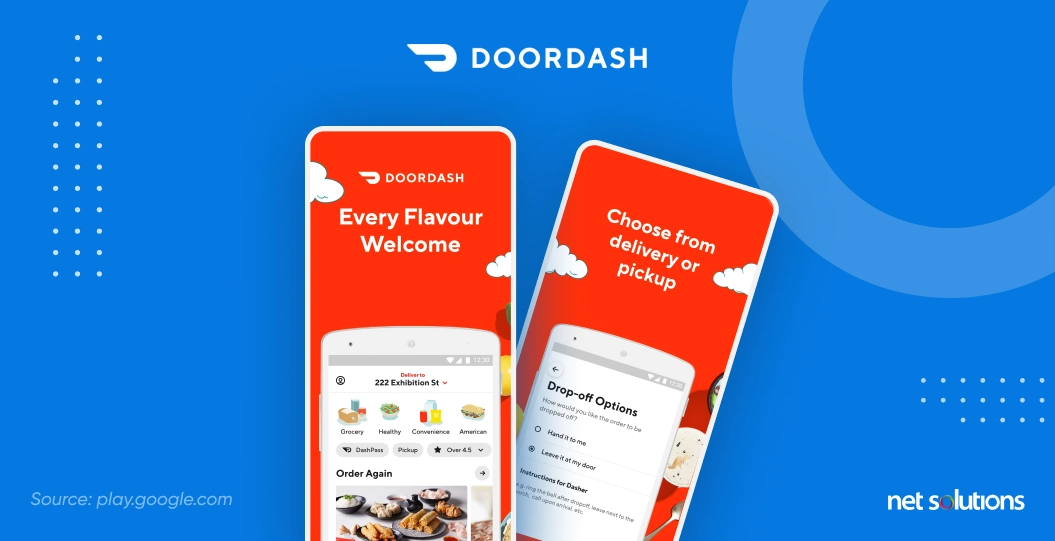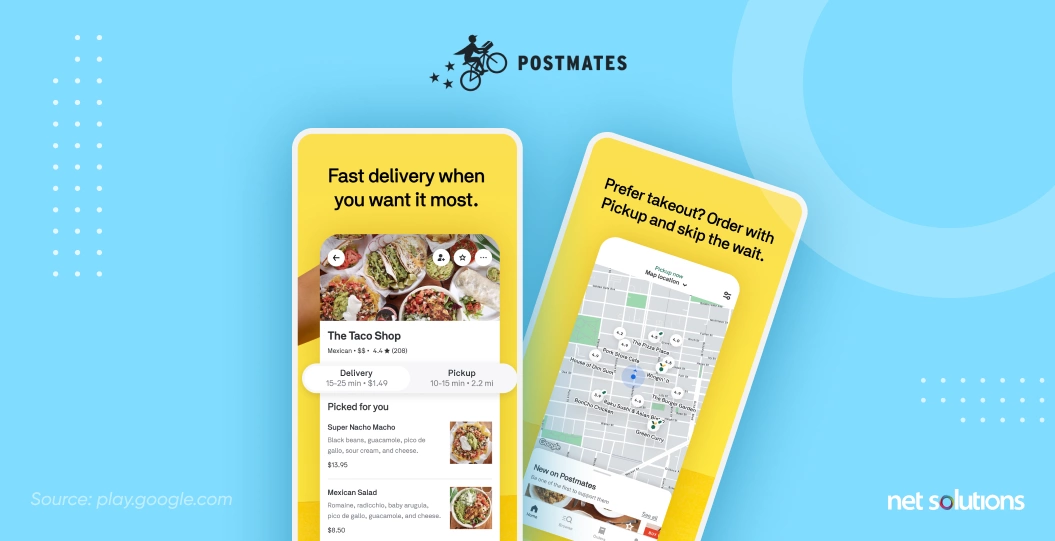Food delivery apps have become a staple in the tech industry, with their popularity and market size continuing to grow. Our blog delves into the industry’s current state, including market size, growth, consumer trends, and future projections. It offers a comprehensive look at the key players and their strategies for success, providing valuable insights for entrepreneurs looking to enter or expand the market.

The size of the global food service market reached 2.52 billion U.S. dollars in 2021. This figure was forecast to grow to 4.43 billion U.S. dollars in 2028, showing a CAGR of 9.9 percent from 2021 to 2028.
Why are food delivery apps so successful? After all, it’s no secret that turning a profit in the restaurant industry is notoriously challenging.
The answer? Convenience.
Consumers are willing to pay extra to receive their meals at their doorstep.
As a tech entrepreneur, it’s time to explore how to tap into this demand for convenience and turn it into a profitable venture.
Editor’s Note: No lies detected. As I write these words, I’m eating an overpriced poke bowl I ordered from Uber.
How much money is there in food delivery apps?
Revenue is expected to show an annual growth rate (CAGR 2023-2027) of 12.33%, resulting in a projected market volume of US$1.45tn by 2027.
Net Solutions has put together this list of the best food delivery apps for 2024. These food ordering and delivery apps are some of the market’s most successful, user-friendly apps. If you’re considering entering the industry, you’ll want to study them and learn from their success.
The secret is to combine the most functional food delivery app features with a user-friendly approach that results in a highly profitable business. Net Solutions has put together a list of the best food delivery apps for 2024 that can help you pick an open perspective.
These food ordering and delivery apps are some of the market’s most successful food delivery apps. So, If you’re considering entering the industry, you must study them and learn from their success.

We respect your privacy. Your information is safe.
Understanding the Business-to-Business-Consumer (B2B2C) model
Remember that successful companies built their food ordering and delivery apps with both businesses (brick-and-mortar restaurants) and consumers (people who order $22 poke bowls) in mind. That makes it a B2B2C model, not just a B2C or a B2B model.
To succeed in this competitive field, you must design an app that allows businesses to manage orders, serve customers, and interface with your company. They’ll partner with you if you can help them boost sales, cut costs, and reach a broader market. Learn from the top 10 food delivery apps outlined below, and when you’re ready to create your food delivery app, Net Solutions can help.
Top 10 successful online food delivery apps in the world
Are you ready to savor the flavor of success in the booming market of food delivery apps? Our blog “Top 10 Food Delivery Apps in the world” is a culinary journey through the industry’s key players and their winning recipes for success. Let’s dive right in.
1. Zomato: A leader in the food delivery industry
Zomato is an online restaurant search and delivery platform founded under the name ‘Foodiebay’ in 2008. The India-based company did so well in its domestic market that Uber Eats (see below) sold all its Indian business to them for $400 million. Today, you can find Zomato in 24 countries and more than 10,000 cities across the globe. The platform’s success reached a new height in 2021, which witnessed a 39x oversubscribed IPO with USD 46 billion in shareholder bids.

What makes Zomato stand out?
- Easy information sharing–almost like social networking for foodies
- Wide-ranging, intuitive search capabilities
- Easy sorting based on a user’s preferences
- An easy-to-navigate knowledge base to solve customers’ problems
- Streamlined review features
- Complete user profile
2. Uber Eats: The convenience of food delivery at your fingertips
Uber Eats is operational in over 10,000 cities across 90 countries around the world. Their market dominance means many restaurants are willing to work with them. This guarantees plenty of options for consumers, creating a positive feedback loop for growth.
What makes Uber Eats unique?
Let’s be real. The Uber app can be a bit buggy and doesn’t necessarily have the cleanest UX, but it remains the go-to app for food delivery for millions. That’s the power of brand recognition.
A few app features that do stand out, however, include –
- Group orders (so friends and colleagues can easily split the cost)
- “Schedule Later” feature that allows users to delay delivery until they’re ready to eat
- Simple re-orders, so users can order their favorite meals with minimal effort
3. FoodPanda: A global giant in food delivery
FoodPanda is another online food ordering app available in 41 countries. Headquartered in Berlin, the firm has partnered with nearly 40,000 local restaurants to provide on-time delivery.
What sets FoodPanda apart?
- Wide selection of restaurants
- Easy access to rebates and special offers
- Seamless payments
4. Swiggy: A food delivery pioneer in India
Swiggy is a top-rated mobile app based in Bengaluru, India. With close to 1,500,000 downloads in the Google Play store, Swiggy has been rated the No.1 online food delivery app in India and is currently available in almost every city.
What makes Swiggy a top player?
- Seamless GPS to help users order from nearby restaurants
- A clear focus on the Indian market
- Wallet feature that allows users to store money and pay for each transaction from their stored balance
5. Grubhub: The go-to choice for food delivery in the US
GrubHub’s widespread list of more than 30,000 restaurants in more than 800 U.S. cities makes it one of the best food-ordering apps. GrubHub has offices in Chicago, New York, and London.
The GrubHub app was launched in 2004. Arriving early in the game allowed the company to set up a wide range of partnerships, and just like with Uber, market dominance helped maintain their success.
What makes Grubhub a favorite among customers?
- Excellent, live, 24/7 customer support
- Greater filtering and search capabilities
- Easy to save “top picks” for re-ordering
- Plenty of coupons and discounts
6. Deliveroo: A leading food delivery service in Europe
Deliveroo is a London-based food delivery startup that works in over 200 cities. It is the most popular food delivery app in Europe, enabling customers to order food from popular restaurants and restaurants that don’t have a traditional setup for dining. Users are charged based on their orders, while restaurants pay a commission.
What makes Deliveroo a top choice in Europe?
- Wider variety, since it works with non-traditional restaurants
- Access to coupons and discounts
7. Domino’s Pizza: A pizza delivery giant
Domino’s is a well-known pizza delivery company, and its app is world-class. Unlike the other apps listed here, it doesn’t deliver food from multiple restaurants (just its own), but we included it because you’d be hard-pressed to find a better UX when customizing and ordering a meal.
What makes Domino’s Pizza a household name?
- Clear visuals showing what users can order
- Ability to swap toppings, modify orders, and fully customize a meal
- Order tracking that shows every step in the process: Prepping the pizza, putting the pizza in the oven, order pickup, and delivery.
8. Just Eat Takeaway: A global platform for food delivery
Just Eat Takeaway offering is a European food delivery app established in 2001. It partners with more than 82,000 restaurants and earns revenue from commissions.
What makes Just Eat Takeaway a popular choice?
- Simple, streamlined interface
- Excellent search features
- Plenty of coupon codes
9. DoorDash: An innovative food delivery service
DoorDash is one of the world’s most established food delivery apps. It supports over 300 cities in 32 markets. The world’s third-largest pizza chain, Little Caesars Pizza, struck a deal with DoorDash Inc. to add delivery to its operations for the first time in its 60-year history.
What sets DoorDash apart?
- A clear commitment to offer quality food
- On-time delivery
- High customer satisfaction
10. Postmates: A food delivery powerhouse in the US
The Postmates delivery app is available in more than 90 cities throughout the United States. Postmates works like many other food delivery apps, except that it handles groceries and different types of delivery.
What makes Postmates a leading player?
- Flexibility—allowing users to order more than just restaurant food
- Simple, clean interface
- Strong branding around the world
The future of food delivery apps: Trends to watch
There’s one thing you can be sure of when dealing with a multi-billion dollar industry. When you’ve got this much money at stake, you’ll continue to see innovation with new technology, new apps, niche services, and different ways to apply technology to meet consumer demand.
The following are some trends we’re likely to see when it comes to new food delivery apps, and they’re worth paying attention to if you want to break into the market.
1. Restaurant-owned apps and delivery fleets
Like Domino’s pizza (see above), we’re likely to see more restaurant chains designing apps and using their delivery fleets. The advantage of this model is that the restaurant maintains complete control over the customer experience, from branding to app design.
Domino’s app experience is exceptional because it’s tailored to their specific customer journey. There’s simply no way Uber Eats, which partners with thousands of restaurants, could design a generic app that tracks each detail of the order process. Domino’s is also able to take advantage of cross-selling opportunities (e.g., “Do you want breadsticks with your pizza?) far more efficiently than the third-party apps ever could.
2. The growth of grocery delivery
Companies like Instacart allows shoppers to order groceries from their favorite supermarkets, and the trend is becoming increasingly popular. This lucrative market saw a considerable uptick during Covid-19 since people wanted to stay out of the stores. Now that customers are hooked on the service, we will likely see continued growth.
One thing worth noting is that Instacart has been called into question for its pricing model. It’s hard to tell how much extra you’re paying for the groceries you order online—sometimes there’s no markup (which means the store has paid for a partnership), while other times the items are priced higher. Instacart also earns a monthly subscription fee.
Perhaps there’s a market for a grocery delivery app with more transparent pricing? One thing we know for sure is that busy professionals are willing to pay good money to have things delivered.
3. The rise of subscription-based models
Recurring revenue is something Software as a Service (SaaS) companies love because it allows them to predict profits over time. It makes investors happy and leads to more significant infusions of capital. That capital, in turn, helps companies dominate their market.
Many of the best food delivery apps listed above offer monthly subscriptions that provide discounts, thereby increasing customer loyalty.
4. Pre-made meals and meal kit deliveries
Companies like Freshly offer pre-made, healthy meals that are easy to heat up in the microwave. These are less expensive for the consumer than ordering from restaurants and lend themselves perfectly to a subscription model.
Another fascinating phenomenon in the world of food app delivery is the meal kit. Companies like Blue Apron provide all the ingredients and easy-to-follow instructions that help home chefs cook excellent meals. Not only does this save time, but it also helps people learn their way around the kitchen if they’re apprehensive about cooking.
It’s also not a wrong way to address the Millennial and Gen-Z market, many of whom do less cooking than their Gen-X and Boomer counterparts—even though they’re entirely into cooking meals at home.
5. The impact of artificial intelligence and robotics
Artificial Intelligence (AI) and Robotics can significantly impact the future of food delivery apps. One way AI can be used is by implementing chatbots, which can handle customer inquiries and orders, allowing for a more efficient and streamlined ordering process.
On the other hand, robots can be utilized for tasks such as food preparation and delivery, potentially increasing the speed and accuracy of these processes. Additionally, using AI and robotics in food delivery apps can lead to company cost savings and improved customer experience.
6. The role of social media and influencer marketing
Social media and influencer marketing is becoming increasingly important for food delivery apps as they look to reach new customers and promote their products. Social media platforms such as Instagram, Facebook, and Twitter can showcase the food delivery apps offer and provide information about promotions and discounts.
Influencer marketing is where social media influencers are paid to promote a product or service. They can effectively reach potential customers through sponsored posts, stories, or videos featuring the food delivery apps and their food. By leveraging the reach and influence of social media and influencer marketing, food delivery apps can increase brand awareness and drive sales.
How Net Solutions helped build a well-functional Food Ordering App for Scoff?
Lauren Steenholdt and her brother Blair identified a gap in online food delivery services for local restaurants. They aimed to create a platform emphasizing hyper locality for customers and local vendors.
Net Solutions assisted the company in realizing its unique vision, launching an MVP on a limited budget, providing technical advice and support, and implementing effective project management to deliver on time. If you are looking for a mobile app development company to turn your ideas into reality, we can help you establish yourself in the ever-expanding food delivery industry by creating an excellent app.
Frequently Asked Questions
1. What are the legal requirements for starting a food delivery business?
To start a food delivery business, you need licenses and permits from local, state, and federal agencies, including a food service establishment permit, a food handler’s card, and a business license. You should be prepared for inspections by local health departments to ensure compliance with food safety regulations and comply with transportation and delivery laws and regulations. Consult an attorney or local government agency to ensure compliance with all necessary regulations.
2. How do I choose the right delivery software and equipment for my business?
When choosing delivery software and equipment for your business, it’s important to consider the specific needs of your operation, which include the size of your business, the types of products you will be delivering, and your budget. Research different options and compare features, pricing, and customer reviews.
3. How do I set competitive pricing for my food delivery services?
Analyze your costs, such as food, labor, delivery, and other operational costs. Consider any additional services you provide, like packaging, customer service, and delivery time. You can use different strategies like dynamic pricing, promotional pricing, and more. It’s essential to regularly review and adjust your prices as needed to stay competitive in the market.
4. How can I build relationships with local restaurants and food suppliers?
Networking, reaching out to them directly and offering value. Attend local food and restaurant industry events to meet potential partners. Research and identify restaurants and food suppliers that align with your business’s values and vision. Offer them incentives like a commission or discounts to join your platform.

















